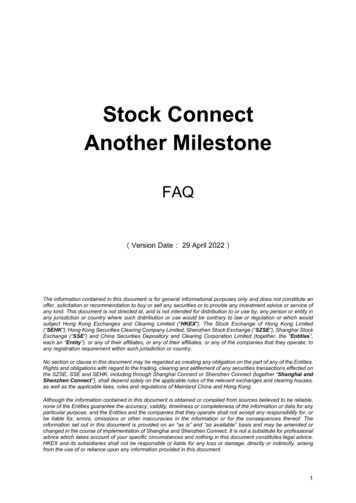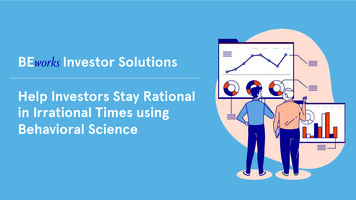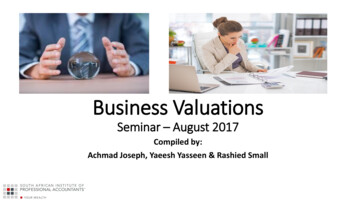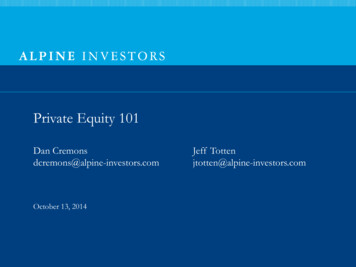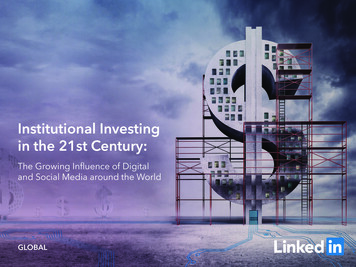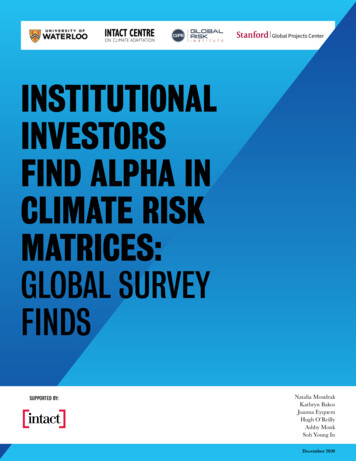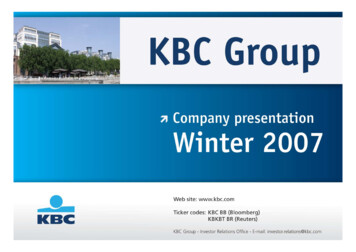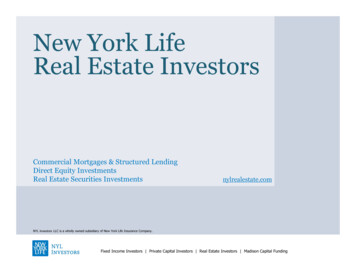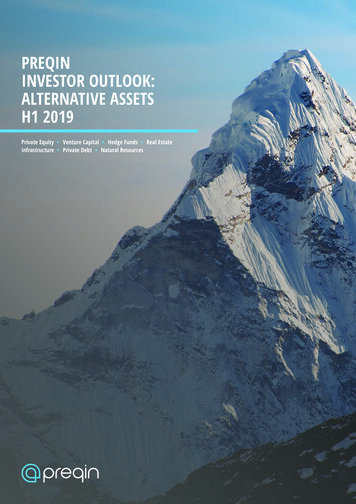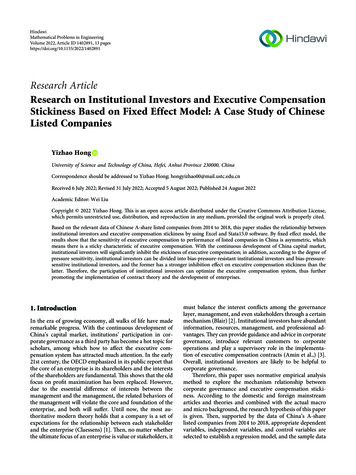
Transcription
HindawiMathematical Problems in EngineeringVolume 2022, Article ID 1402891, 13 pageshttps://doi.org/10.1155/2022/1402891Research ArticleResearch on Institutional Investors and Executive CompensationStickiness Based on Fixed Effect Model: A Case Study of ChineseListed CompaniesYizhao HongUniversity of Science and Technology of China, Hefei, Anhui Province 230000, ChinaCorrespondence should be addressed to Yizhao Hong; hongyizhao00@mail.ustc.edu.cnReceived 6 July 2022; Revised 31 July 2022; Accepted 5 August 2022; Published 24 August 2022Academic Editor: Wei LiuCopyright 2022 Yizhao Hong. This is an open access article distributed under the Creative Commons Attribution License,which permits unrestricted use, distribution, and reproduction in any medium, provided the original work is properly cited.Based on the relevant data of Chinese A-share listed companies from 2014 to 2018, this paper studies the relationship betweeninstitutional investors and executive compensation stickiness by using Excel and Stata15.0 software. By fixed effect model, theresults show that the sensitivity of executive compensation to performance of listed companies in China is asymmetric, whichmeans there is a sticky characteristic of executive compensation. With the continuous development of China capital market,institutional investors will significantly inhibit the stickiness of executive compensation; in addition, according to the degree ofpressure sensitivity, institutional investors can be divided into bias-pressure-resistant institutional investors and bias-pressuresensitive institutional investors, and the former has a stronger inhibition effect on executive compensation stickiness than thelatter. Therefore, the participation of institutional investors can optimize the executive compensation system, thus furtherpromoting the implementation of contract theory and the development of enterprises.1. IntroductionIn the era of growing economy, all walks of life have maderemarkable progress. With the continuous development ofChina’s capital market, institutions’ participation in corporate governance as a third party has become a hot topic forscholars, among which how to affect the executive compensation system has attracted much attention. In the early21st century, the OECD emphasized in its public report thatthe core of an enterprise is its shareholders and the interestsof the shareholders are fundamental. This shows that the oldfocus on profit maximization has been replaced. However,due to the essential difference of interests between themanagement and the management, the related behaviors ofthe management will violate the core and foundation of theenterprise, and both will suffer. Until now, the most authoritative modern theory holds that a company is a set ofexpectations for the relationship between each stakeholderand the enterprise (Claessens) [1]. Then, no matter whetherthe ultimate focus of an enterprise is value or stakeholders, itmust balance the interest conflicts among the governancelayer, management, and even stakeholders through a certainmechanism (Blair) [2]. Institutional investors have abundantinformation, resources, management, and professional advantages. They can provide guidance and advice in corporategovernance, introduce relevant customers to corporateoperations and play a supervisory role in the implementation of executive compensation contracts (Amin et al.,) [3].Overall, institutional investors are likely to be helpful tocorporate governance.Therefore, this paper uses normative empirical analysismethod to explore the mechanism relationship betweencorporate governance and executive compensation stickiness. According to the domestic and foreign mainstreamarticles and theories and combined with the actual macroand micro background, the research hypothesis of this paperis given. Then, supported by the data of China’s A-sharelisted companies from 2014 to 2018, appropriate dependentvariables, independent variables, and control variables areselected to establish a regression model, and the sample data
2are verified by using Stata15.0; finally, the hypothesis istested one by one and conclusions and suggestions are givenaccordingly.2. Literature Review and Research Assumptions2.1. Literature Review. Institutional investors are generatedand active in capital market transactions. They must complywith local laws and regulations and be approved by thegovernment before they can engage in investment activities.They are subject to strict restrictions. Institutional investorsare a broad group with certain differences in individualpreference, investment philosophy, economic wealth level,and professional level. Therefore, it is difficult to unify thedefinition of institutional investors. The term “stickiness” isphysically used to describe the relationship between fluidstress and its rate of deformation. Then borrowing this idea,“stickiness” is also widely used and explored in management.Graver [4] first selected the relevant data of 376 companies in 1970–1996 and found that the monetary compensation of chief executive officer is positively correlatedwith the net profit of the company, and the monetarycompensation of chief executive officer will significantlyincrease when the company’s profit increases, but this willnot happen when the profit decreases. Heart [5] throughinvestigation and research, it is found that the proportion ofshares held by investors in an organization has a significantpositive correlation with their remuneration to senior executives. On this basis, David et al. [6] first proposed theconcept of heterogeneity between institutions and investorsat the end of the twentieth century and found that the actualshareholding ratio of some radical institutions and investorswas significantly negatively correlated with employees’salaries, while the actual shareholding ratio of some moreconservative institutions and investors was not significantlycorrelated with employees’ salaries. Subsequent Corneetet al. [7] also put forward a similar view: generally speaking,the proportion of shares held by institutional investors issignificantly positively correlated with the cash flow andreturn rate of the enterprise throughout the operationprocess; in terms of breakdown, institutional investorsholding shares that do not have any business relationshipwith listed companies are positively and closely related tocash flows and return rates in the production and operationof enterprises, while institutional investors that have a potential relationship with companies have no significantimpact on cash flow returns in the operation of enterprises.Chinese scholar Zhihong Yi et al. [8] put forward theview that the existence of institutional investors inhibits thestickiness of executive compensation, and on this basis, theauthor classified the sensitivity of executive compensationinto two types and found that this kind of pressure-resistingtype of investors can greatly improve the performancesensitivity of enterprises to compensation. After that,Xiaoshan Chen and Hongduo Liu [9] explored the depth andbreadth of institutional investment shareholding on theexcess compensation of senior executives and divided theinstitutions into boosters, supervisors, and bystanders.However, there are also some scholars, who hold opposingMathematical Problems in Engineeringopinions. For example, Chao Li et al. [10] selected listedcompanies in China from 2004 to 2008 as samples, and usedlinear probability, probit, and other regression models toshow that China institutional investment is not related toexecutive compensation; Li and Wang [11] believed thatunder the “one-share-one-vote” system in China, institutional investors, as holders of tradable shares, cannot directlyaffect corporate governance and executive compensation.Empirical evidence also shows that there is no significantrelationship between institutional investors and executivecompensation.To sum up, institutional investors will optimize investment and management by integrating factors such as thescale, industry, culture, strategy, investment, and financingopportunities of the enterprise, so as to improve the internalgovernance of the enterprise, increase the sensitivity ofexecutive compensation performance, comply with theperformance contract system and curb the stickiness ofexecutive compensation. In addition, different types of institutional investors have different degrees of influence onexecutive compensation, which also lays a foundation forsubsequent empirical research.2.2. Research Assumptions. According to the optimal contract theory and relevant contents of incentive theory, thereis a contractual relationship between shareholders and senior management, which maintains and restricts thetransaction cooperation between the two parties and seeksthe development of the company under the premise ofsharing the responsibility risk. At the same time, shareholders are required to pay certain remuneration to seniormanagement as an incentive and warning. According to theincentive theory, executive compensation should be highlypositively correlated with the performance they create.When the performance they create rises, the compensationthey receive should also rise, which is the combined effect ofpositive reinforcement and negative reinforcement. However, according to the description of principal-agent theoryand information asymmetry theory, in fact, the managementis responsible for the real operation, development, andgovernance of the company, and there is a conflict of interests between the management and shareholders. Thedynamic opportunity to pursue short-term interests resultsin the executive compensation contract not being effectivelyperformed. First, senior managers are generally selected byshareholders themselves. They have professional advantages,management advantages, and information advantages. Onthe whole, professional managers are definitely beneficial tothe long-term development of the company. When theperformance of senior executives declines, shareholders willgenerally have a “failure tolerance” mentality and will notimpose too much punishment on senior executives (Lai andLeng) [12]. If the punishment is too high, the managementmay lose their enthusiasm for work or start their ownbusiness with their unique advantages, which is not worththe cost to the company. From a psychological point of view,when the performance of senior executives drops, shareholders will impose a slight punishment or even no
Mathematical Problems in Engineeringpunishment, which will cause the senior executives to feelashamed and work harder in the next stage, which is actuallya kind of reverse incentive. Secondly, shareholders, after all,as the owners of the company, delegate the management ofthe company to the senior management and enjoy thebenefits themselves. For the senior management, there willbe an imbalance in their hearts. They think that their effortsdo not match the remuneration and most of the company’sbenefits flow to shareholders. Therefore, Zhu et al. [13]proposed that when the performance of senior executivesdecreased, the senior executives were dissatisfied with thepenalty of salary reduction and even used their power tochange their salaries. Third, as a listed company, executivecompensation will be disclosed to the public in the annualreport. If the executive compensation is reduced too much, itmay imply poor management of the enterprise and affect thereputation of the executive. Therefore, companies generallydo not significantly reduce executive compensation.Fourthly, Fang (2011) [14] believed that the salary of thecompany’s staff is a health factor, no matter what the salarysystem is set, the staff should only reach a neutral satisfactionstate. On the contrary, when the salary system deteriorates tobelow the expectations of the staff, a negative attitude will begenerated, resulting in a decrease in work efficiency and aconsequence of the company’s poor development. Theeconomic concept can be introduced from this, that is, salaryis a kind of rigid demand. When the company’s performancedrops, the salary will not drop too fast, which is a gentlecurve. To sum up, the company may impose “heavy rewardsand light penalties” or even “heavy rewards and zero penalties” on senior executives. Based on this, this paper proposes the hypothesis H1 as follows:Hypothesis H1: Chinese listed companies have stickycharacteristics of executive compensation.The theory of institutional shareholder activism pointsout that the scale of institutional investment has expandedrapidly since the 1980s. Many listed companies hold morethan half of their shares in institutional investment. Likeshareholders, they pay attention to the long-term development of enterprises. The purpose of investment is to returnand obtain the maximum benefit with the minimum cost.How to manage the enterprise is the new target of institutional investors in the aspects of fundraising, investment,management, and withdrawal. What’s more, for institutionalinvestors, there is also pressure on customers to managetheir financial interests. Therefore, it is particularly important to invest correctly and effectively. First, the organization has a very rich and comprehensive investmentmanagement team. From the perspective of corporate investment, Liang (2015) [15] pointed out that the management is overconfident. Some radical executives may increasetheir investment due to performance-based compensation,which will increase their chances of getting compensationand improve their status and reputation. However, in thisway, the risk of corporate investment failure will increasesignificantly, thus infringing on the interests of shareholdersand exposing the enterprise to the risk of nonsustainabledevelopment. Li and Mi [16] believed that when institutionalinvestors enter the enterprise, their rich management3experience can formulate corresponding mechanismsaccording to specific conditions, so as to prevent this fromhappening without damaging the interests of the enterpriseto seek maximum marginal revenue. Secondly, institutionalinvestors can also play a regulatory role. Institutional investors have the right to remind or reject the radical andunreasonable investment decisions made by senior executives to safeguard the rights and interests of enterprises.Thirdly, the institutional investor team has abundant resources and information. They can bring high-quality customers to the enterprise and set up a more perfectinvestment system to increase the probability of successfulinvestment and restrain the executives from making aggressive and subjective investment decisions. Finally, Li andLi [17] confirmed through the panel and cross-sectional datathat due to the objectivity and completeness of institutionalinvestors and their large shareholding, they are not easy tosell off. Therefore, they pay attention to the long-term development interests of enterprises, and their participation incorporate governance can also reduce the informationasymmetry between the governance layer and the management. Compared with corporate executives, institutionalinvestors are more in line with the interests of shareholders.Shareholders can be informed of the company’s operation,management, and grasp of market conditions throughvoting at shareholders’ meetings, private negotiations, explanatory letters, and other methods, so as to obtain a morecomprehensive understanding of the information. Based onthis, this paper proposes the hypothesis H2 as follows:Hypothesis H2: Institutional investors inhibit thestickiness of executive compensation.In the previous literature research, institutional investorsare a wide range of groups, and their shareholding ratio,shareholding duration, investment philosophy, degree ofrisk preference, and the degree of state intervention havegreat differences in corporate governance and executivecompensation contracts. If we only consider the impact ofinstitutional investors on the stickiness of executive compensation, there may be certain research errors that affect thejudgment of the enterprise. The major institutional investorsin China include six categories: securities investment funds,social security funds, qualified foreign institutional investors, securities companies, insurance companies, and trustcompanies. This paper refers to the classification method ofinstitutional investors by Brickley et al. [18]. See Table 1 fordetails.For the pressure-resistant institutional investors, theypay more attention to how to prolong the company’s lifecycle and stand firm in the competitive industry for a longtime (Zhang and Chen) [19]. Coupled with the abundantresources and information advantages of the team, the teamwill generally actively participate in corporate governance,promote the improvement of corporate organizationalstructure, enhance the degree of corporate internal governance, enhance the overall reputation of the company andincrease the interests of stakeholders. At the same time, theorganization will also play the role of supervisor, especiallyin preventing and negotiating the behaviors of senior executives that are detrimental to the interests of the company.
4Mathematical Problems in EngineeringTable 1: Classification of institutional stitution nameInvestment themeInvestment ratio limitSecuritiesinvestment fundsRisk coexists and marginalrevenue is maximized.YesResponsible investment,safety firstQualified foreignLong-term stableinstitutionaldevelopment andinvestorsmultilateral cooperationCapital appreciation,Securities companybusiness interestsInsurance company Seeking profit from stabilityValue investment with highTrust companyliquiditySocial security fundThey are satisfied with the sense of accomplishment broughtby managing and developing the company. Yi et al. [8] foundout from the companies that selected the A-shares listed inShanghai and Shenzhen stock exchanges of China from 2004to 2006 that this kind of pressure-resistant investors cangreatly improve their performance sensitivity to compensation for enterprises, while the relationship between theinvestors of pressure sensitive institutions and their compensation management performance is not significant,which proves this. For companies, the addition of pressureresistant institutional investors will make the supervisioncost lower than the incremental revenue, thus forming astrategic alliance between shareholders and institutionalinvestors to promote the long-term development of thecompany. For the pressure-sensitive institutional investors,they have more commercial interests in the company (Jiangand Li) [20]. For example, insurance companies, apart fromcapital investment to protect their value, are more concernedabout insurance coverage and the probability of accidentswith customers and will not actively participate in corporategovernance. This will not only not be of special help to theirown interests but will also increase additional managementcosts, which will do more harm than good. Based on this, thispaper proposes the hypothesis H3 as follows:Hypothesis H3: Bias-pressure-resistant institutional investors have stronger inhibition on executive compensationstickiness than bias-pressure-sensitive institutional investors.3. Research Design3.1. Sample Selection and Data Sources. This paper selects thelisted companies in Shanghai and Shenzhen A-share marketof China from 2014 to 2018 as the research sample, mainlystudying the relationship between corporate governance andexecutive compensation stickiness. In order to ensure thevalidity of the data and the empirical results, the followingmeasures are taken to deal with the samples:(1) If the enterprises with ST and ST are excluded,such enterprises may have losses for three consecutive years, and the relevant indicators have abnormal conditions, which may cause large errors inthe empirical results, so they are excluded;YesYesRelationship with investeeDo not intervene in corporategovernance under stringent marketsupervision conditionsActive participation in corporategovernance with high independenceActively participate in corporategovernance, rational investmentYesLow independence, often as a stockunderwriterTwo-way benefitNoTwo-way benefitNo(2) Excluding financial and insurance enterprises, whichhave different financial statements from generalenterprises and lack of universality, so they areexcluded;(3) The enterprises with incomplete data of relevantvariables are excluded, because some enterpriseshave undisclosed or missing data, which will affectthe operation of the model, so they are excluded;(4) If the companies with abnormal indicators are excluded, the companies with negative net profit for thecurrent year, asset-liability ratio, and institutionalinvestors holding more than 100% or negative will beexcluded. If the companies with abnormal indicatorswill cause deviation from the empirical results, theywill be excluded.Through the abovementioned processing, a total of 7,670samples were selected, and the data were mainly fromRESSET database. In the empirical part, this paper usesStata15.0 to conduct comprehensive processing and statistical analysis on the model data.3.2. Definition of Major Variables(1) Executive compensation (Lnpay). In the RESSETdatabase, the total compensation of the top threehighest paid executives is selected and the naturallogarithm is used to remove the dimension tomeasure the executive compensation.(2) Corporate performance (Lnperf ). Referring to themethod of Fang [21], the net profit after excludingnonrecurring profit and loss is taken as a measure ofthe company’s performance. In addition, the performance Down of the test variable is defined as:when the company’s performance drops year-onyear, the value is 1, and vice versa, 0.(3) Institutional investors (IIS). If there is an institutional investor holding 1 in the sample company,otherwise 0.(4) Bias-resistant institutional investors (PRII). If theactual proportion of total holdings of the pressure-
Mathematical Problems in Engineering5Table 2: Definition of variables.Executive compensationCorporate performanceVariablecodeLnpayLnperfDecline in performanceDownVariable nameInstitutional investorIISBias-resistant institutionalinvestorsPRIISeparation of two postsDualHolding ratioShareVariable definitionThe natural logarithm of the total remuneration of the top three executivesNatural logarithm of net profit after excluding nonrecurring profit and lossIf the results of the company decrease year-on-year, 1 will be taken, otherwise, 0 will betaken.If the company has institutional investors holding shares, 1 will be taken; otherwise, 0will be taken.Bias-resistant institutional investors take 1, otherwise, take 0CentralCentralCompany sizeRate of return on commonstockholders’ equityYearIndustryLnsizeIf the two positions of chairman and general manager concurrently take 1, otherwisetake 0Proportion of shares held by the largest shareholderThe ultimate controllers are SASAC and financeThe ministry and other central institutions and the state-owned enterprises directlyunder the central government shall take 1, and the contrary shall take 0Ratio of total liabilities to total assets at year-endProportion of independent directors to total directorsIf the place of incorporation of the company is in the west, 1 will be taken; otherwise, 0will be taken.If the place of incorporation of the company is central, 1 will be taken; otherwise, 0 willbe taken.Natural logarithm of total assets of a companyROENet profit divided by net assetsYearIndustryVirtual variables that control annual influencing factorsVirtual variables, controlling industry influencing factorsCentral government controlCGAsset-liability ratioBoard independenceLevInddWestWestresistant institutional investors is greater than theactual proportion of total holdings of the pressuresensitive institutional investors, it is recorded as 1,otherwise, it is taken as 0.(5) See Table 2 for the specific definition of controlvariables.(2) In order to verify the relevant assumptions proposedby H2, model 2 is constructed with reference to theresearch methods of Lielan Wu and Wen Xu (2019)[22].Lnpayi,t β0 β1 Lnperf i,t β2 Lnperf i,t Downi,t β4 Lnperf i,t Downi,t β5 Downi,t β6 IISi,t β7 Duali,t β8 Sharei,t β9 CGi,t3.3. Model Construction(1) In order to verify the relevant assumptions proposedby H1, model 1 was constructed with reference to theresearch method of Junxiong Fang (2009) [21].Lnpayi,t α0 α1 Lnperf i,t α2 Lnperf i,t α7 Levi,t α8 Inddi,t α9 Westi,t β13 Centrali,t β14 Lnsize β15 ROE β16 Industryi,t β17 Yeari,t εi,t .(2) Downi,t α3 Downi,t α4 Duali,t α5 Sharei,t α6 CGi,t β10 Levi,t β11 Inddi,t β12 Westi,t(1) α10 Centrali,t α11 Lnsize α12 ROE α13 Industryi,t α14 Yeari,t εi,t .In model 1, when the corporate performance(Lnperf ) rises, Down is 0, and the sensitivity of executive compensation (Lnpay) to the corporateperformance (Lnperf ) is α1 ; when the corporateperformance (Lnperf ) drops, Down is 1, and thesensitivity of executive compensation (Lnpay) to thecorporate performance (Lnperf ) is (α1 α2 ). Ifα1 〉(α1 α2 ), that is α2 〈0 , it indicates that there is asticky characteristic of executive compensation.In model 2, the effect of institutional investors (IIS)on the stickiness of executive compensation isstudied by adding the triple interaction term(Lnperf Down IIS) of institutional investors (IIS)with corporate performance (Lnperf ) and performance decline test variable (Down). Referring to therelevant mechanism of model 1, when the coefficientof the interaction between corporate performance(Lnperf ) and performance decline test variable(Down) (Lnperf Down) α2 is significantly negative,the sticky characteristic of executive compensationexists; In model 2, according to the partial derivativeand interaction principle, when the triple interaction(Lnperf Down IIS) coefficient of an institutionalinvestor (IIS), corporate performance (Lnperf ) andperformance decline test variable (Down) is opposite
6Mathematical Problems in Engineeringand significant to the interaction (Lnperf Down)coefficient of corporate performance (Lnperf ) andperformance decline test variable (Lnperf Down) inthe model 1, that is, the triple interaction(Lnperf Down IIS) coefficient of institutional investors (IIS), corporate performance (Lnperf ) andperformance decline test variable (Down) β2 is significantly positive, indicating that institutional investors inhibit the stickiness of executivecompensation.(3) Model 3 is constructed to verify the relevant assumptions proposed by H3.Lnpayi,t c0 c1 Lnperf i,t c2 Lnperf i,t Downi,t PRIIi,t c3 Lnperf i,t PRIIi,t c4 Lnperf i,t Downi,t c5 Downi,t c6 PRIIi,t c7 Duali,t c8 Sharei,t c9 CGi,t (3) c10 Levi,t c11 Inddi,t c12 Westi,t c13 Centrali,t c14 Lnsize c15 ROE c16 Industryi,t c17 Yeari,t εi,t .In model 3, similarly, when institutional investors arebiased to resist (PRII 1) and corporate performance rises(Down 0), the sensitivity of executive compensation(Lnpay) to corporate performance (Lnperf ) is (c1 c3 ), andthe sensitivity of executive compensation (Lnpay) to corporate performance (Lnperf) when corporate performance declines (Down 1) is (c1 c2 ) (c3 c4 ), which the stickinessof executive compensation is (c1 c3 )/(c1 c2 c3 c4 );When institutional investors are biased pressure sensitive(PRII 0) and corporate performance rises (Down 0), thesensitivity of executive compensation (Lnpay) to corporateperformance (Lnperf) is c1 , the sensitivity of executive compensation (Lnpay) to corporate performance (Lnperf) whencompany performance declines (Down 1) is (c1 c4 ), whichthe stickiness of executive compensation is (c1 )/(c1 c4 ). If(c1 )/(c1 c4 )〉 (c1 c3 )/(c1 c2 c3 c4 ), then hypothesis H3 holds.4. Empirical Analysis4.1. Descriptive Statistics. According to Table 3, it can be seenthat the average value of executive compensation (Lnpay),which is an explanatory variable, is 14.5133, and the standarddeviation is 0.6699, indicating that there is little change inexecutive compensation of listed companies from 2014 to2018. This also makes sense. For listed companies, executivecompensation needs to be disclosed. Moreover, executivecompensation also represents the company’s strategicplanning. If the change is too large, it will have an importantimpact on both the enthusiasm of the executive and thereputation of the company. Therefore, executive compensation will not change much in five years. The maximumvalue of corporate performance (Lnperf ) as an explanatoryvariable is 23.2340 and the minimum value is 15.1554. Thisshows that the performance of listed companies in Chinavaries greatly due to their different scale, industry, andstrategic objectives. The average value of the performanceDown variable (Down) is 0.3099, which indicates that about30% of the companies in China experienced a year-on-yeardecline in performance in the past five years, possibly due tothe government’s macro control and corporate tighteningstrategies. The average value of PRII is 0.2912, which indicates that the biased pressure-sensitive institutional investors are dominant. Among the control variables, the averagevalue of Dual is 0.2568, which indicates that about 75% of thelisted companies have different governance levels from themost powerful leaders of the management. On the whole, thelisted companies in China have good governance in theaspect of dual. The maximum value of the largest shareholder’s controlling share is 0.7482, while the minimumvalue is 0.0903. This shows that the sample companies have alarge difference in ownership structure, which also showsthat the companies selected in this paper are universal andcover the basic situation. The average value of CG is 0.1246,which indicates that about 12% of enterpri
executive compensation; Li and Wang [11] believed that under the "one-share-one-vote" system in China, cannotdirectly affect corporate governance and executive compensation. Empirical evidence also shows that there is no significant relationship between institutional investors and executive
